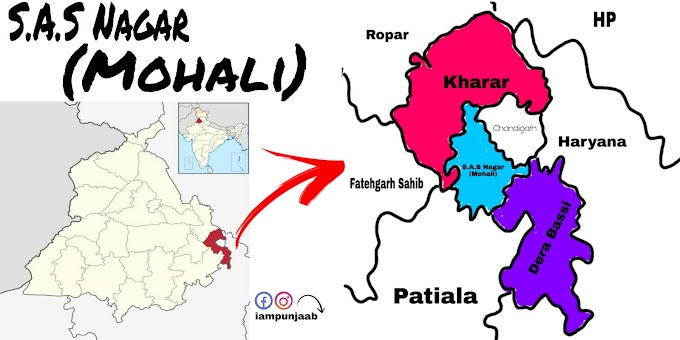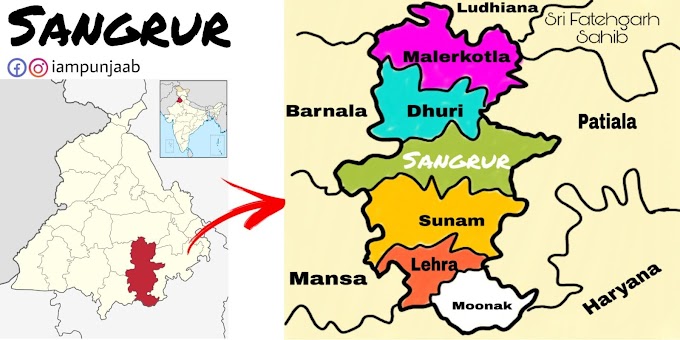 |
| View of Jalandhar, Doaba region's most famous district |
Know about district series, lets
talk about district Jalandhar. It is the most famous district in the Doaba
region of Punjab. The thing that separates Jalandhar from all the districts of Manjha and Malwa region of Punjab, is
the manufacturing of sports goods and
equipment. Jalandhar is renowned not only in Punjab but all over the world for
sports related goods. Sports equipment from Jalandhar and other related
equipment is used by world-renowned players at international level competitions
such as the Olympics, Asian Games, Commonwealth Games. One of Jalandhar's
roundabout is named Football Chownk due to its popularity as sports equipment
hub. Jalandhar has also been the capital of Punjab from the partition of India
in 1947 to 1953.
Talking about the name of
Jalandhar district, the word Jalandhar itself is a very meaningful word.
According to the local language, Jal means water and Andhar means inside so Jalandhar
means the inside water area. But really this means the area between the two
rivers. The names of these two rivers are: Sutlej and Beas. But it is also
believed that the district is named after a demon king, mentioned in the old
puranas and the Mahabharata. According to another legend, it is also mentioned
that Jalandhar is also the capital of the kingdom of Lav, the son of Sri Ram. Another
name of Jalandhar had been- Trigartta. This word means the area between the
three rivers, the Sutlej Ravi and Beas.
Many events in history are
related to Jalandhar. Here are some of them. The mint was established at
Jalandhar during the reign of the King Akbar in the Mughal Empire, in which the
copper coin was minted and the special task of disposing of Jalandhar Doab's
land revenue was entrusted to his minister, Todar Mall. Kartarpur was founded
by Guru Arjun Dev Ji, the fifth Guru of the Sikhs in 1539. During Jahangir's reign,
Jalandhar also became a center of special attention as his twentieth and last
wife, Nurjahan, grew up in Jalandhar district’s, close to Nakodar and Phillaur,
a small town ‘Nurmahal’ or ‘Noormahal’. She built the Nurmahal Sarai there. It
is thought that she spent his childhood in this town ‘Nurmahal’.
Let's look at some of the more
important events. In 1868, the railway line between Jalandhar and Beas was
completed then the railway was opened for rail traffic, and a year later the
railway line was extended to Phillaur city in district. To connect Jalandhar
Doab with the rest of the Punjab, a railway bridge was constructed on the Beas
river in 1869 and the Sutlej river in 1870, leading to increased trade and
economic boom. Mahatma Gandhiji also visited Jalandhar city in March 1921 and
in the middle of April, the following month, a club of 25 women was established
named as Charaka Club (Spinning wheel club). Khatkar Kalan, the ancestral
village of Shaheed Bhagat Singh, used to be part of Jalandhar district, which
was later subdivided under Shaheed Bhagat Singh Nagar (old name Nawanshahar)
district.
Jalandhar city is considered as
the premier of India's sports goods industry. Its roots are in Sialkot,
Pakistan. Hindu and Muslim artisans who made sporting goods before 1947 lived
in this city. After the partition of 1947, many Hindu artisans from Sialkot
city settled in Jalandhar and with their skills, introduced Jalandhar into the
world as the hub of the sports goods industry. The sports goods industry is
mainly concentrated in Jalandhar and Meerut and most of the goods are exported
to the United Kingdom, the United States, Germany, France and Australia.
Tell you about a
special event that took place on April 3, 2020 during the Lockdown Period, a Coronavirus Covid-19 outbreak. Due to low pollution levels, the air quality
index decreased and the slopes of Dhauladhar
mountain ranges of lesser Himalayan in Himachal Pradesh covered by white crystal snow were visible from the city and adjoining villages, which in itself was an
amazing sight. These mountains are 200 km away from the city. Thirty years ago,
it was a sight to behold, when pollution levels were very low. As development
progressed, pollution levels increased and such sightings disappeared.
(continued)










1 Comments
Insightful read! Looking forward to more. best diagnostic centre lead generation services in mohali
ReplyDelete